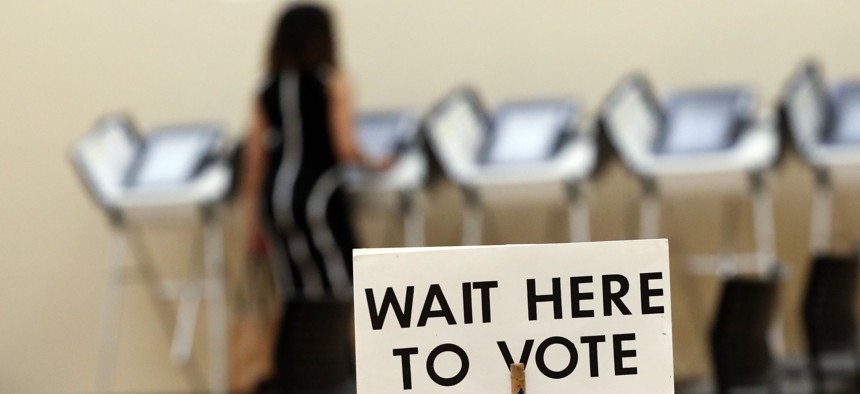$380 Million of Election Assistance Money Only Goes So Far

In this Wednesday, May 9, 2018, photo, Pamela Hampton votes in Sandy Springs, Ga. AP Photo/John Bazemore
An official with the U.S. Election Assistance Commission on Friday acknowledged some of the limits to what the funding can achieve.
NASHVILLE — The $380 million Congress allotted earlier this year for states to upgrade election systems falls well short of what it would take to pay for the widespread replacement of voting equipment, an official with the agency overseeing the funds noted Friday.
"I would equate this money to: not enough to buy new voting systems and too much for some of the small security things that need to be done,” Brian Newby, executive director for the U.S. Election Assistance Commission, told county officials gathered for the National Association of Counties annual conference.
That doesn't mean the money will not be put to good use, he added. “We're seeing states do a lot of creative things," Newby said. For instance, deploying sensors at the county level to detect malicious computer activity and establishing teams of "cyber navigators" who are election security experts.
Newby said the commission moved to award the money to states quickly after it was appropriated in late March. Even so, he cast doubt on whether all of it will be used before the 2018 elections are over, saying: “that’s probably not going to happen to a large degree.”
The EAC has asked states for a brief description of what they plan to do with the money. That document is due next week. Some states have already submitted it, while others have asked for for extensions, according to Newby.

State and local governments control election administration around the U.S.
They saw a significant influx of federal funding for election systems after the 2000 presidential race between Al Gore and George W. Bush, who went on to become president. In that election, controversies with voting in Florida led to legal wrangling that ended in the U.S. Supreme Court. Following that election cycle, Congress passed the Help America Vote Act of 2002, which created the EAC.
Lawmakers authorized about $3.6 billion for states to replace voting systems and to meet the act’s requirements. Congress appropriated about $3.2 billion between fiscal years 2003 and 2010, according to a Congressional Research Service report. Around the nation, many people are still casting votes using equipment that was purchased during that time frame.
Election security garnered renewed attention after the 2016 election when, according to U.S. intelligence officials, Russian-linked hackers probed election systems in at least 21 states.
State officials and others have stressed that no evidence has surfaced indicating that hackers changed any votes or registration information.
Congress appropriated the recent $380 million to states under the Help America Vote Act. The language guiding the use of the funds has some flexibility, so the money can be used for a variety of purposes, not only security. States are required to provide a 5 percent match.
Newby also highlighted the heightened discussions going on currently about the need for voting systems that are not purely electronic, but provide a paper trail that can be audited to check voting results.
Paper ballots, however, can be problematic for blind voters, he said.
"The tension that we have always is how do you focus on security and focus on accessibility,” Newby added. “Neither can be compromised."
Bill Lucia is a Senior Reporter for Government Executive's Route Fifty and is based in Washington, D.C.
NEXT STORY: Measuring Diversity in Local Government Leadership






